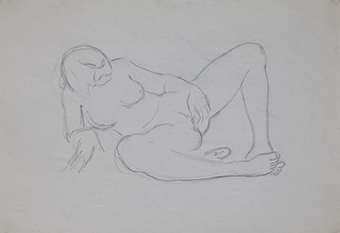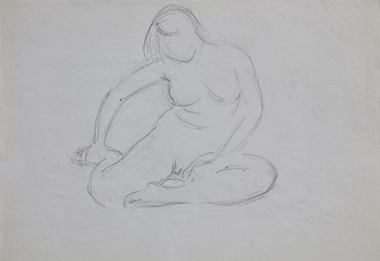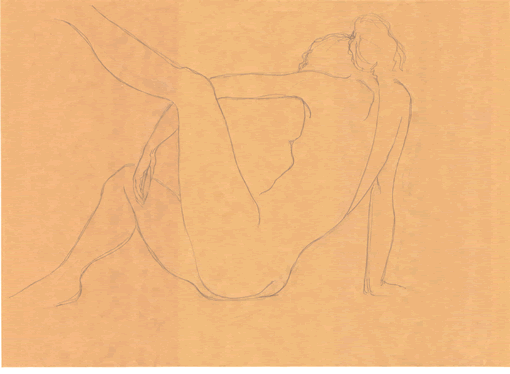The girl with the mirror
.jpg)




1999: Sketches "The Girl With The Mirror"
Pencil 50cm x 35cm

"The Girl With The Mirror"
Plaster 35cm x 30cm


"The girl with the mirror"
bronze 35cm X 30cm

"The Girl with the Mirror" pencil on paper, 70 x 50 cm
.JPG)
"The Girl with the Mirror" pencil and pastel on paper, 70 x 50 cm
.jpg)
"The Girl with the Mirror" pencil on paper, 70 x 50 cm

The Girl with the Mirror,Natural size,Bronze."
Proccess of making the project"The girl with the mirror"
The conception of the idea for the creation of a work of art has many causes; often they seem to be fortuitous. In every case, however, it is directly linked with the way each artist perceives and seeks for the meaning in the aesthetics of the images of the abstraction. This is a law of aesthetic perception in general, as it is composed from the reductive classification of the infinite material of the images of sensory perception.This occurs irrespective of how aware the subject, artist or spectator is of the existence of this law. Thus, either from the outset, or a posteriori, every work appears as a moment in a course that is either individual or historical for humanity.
This work “Girl with Mirror,” is an approach to self-referentiality – reference to the self as position and negation. I regard self-referentiality as a basic element of motion in general. In this work, self-referentiality is expressed through the representation of the reflection of the image of the self in thought as a constant return to the image and in each instance a necessary stage in the evolution of becoming conscious of the self as a whole (process of self-consciousness, part of the process of knowledge).
 |
The overall figure, the representation, of the abstract notion, of the turn towards the self, the precondition for the extension of the thing. A search for inward-facing systems (a line is a system of relationships between points) that, in their reciprocal relationship, also create the elements of a centrifugal force. | |
 |
The abstract notion (general figure) is tested in its interaction with secondary figures, which are abstracted from the images emanating from a familiar object-model. In this stage the general form is confirmed and enriched and acquires individual substance. That is, the manner in which the universal exists within the individual is confirmed. | |
 |
The framework (iron and wood structure) on which the work is built. The framework has the shape of the abstract notion, but now in three dimensions, and this accordingly affects the general planning of the work. Strengthening of the form of the framework with plaster and fibre, to enable it to hold and guide the mass of sculpting clay that will be added. |
|
 |
The addition of the mass (sculpting clay) is done in such a way that each stage of the scale keeps in step with the quest for the basic elements of the character of the form and of a plasticity that, by and large, will be retained and will constitute the unifying element of the work’s plasticity, no matter what its evolution will be in the development of smaller scales. | |
 |
When the clay model has reached a point where the problems of the form in the basic scales I have chosen have been dealt with, the work is refashioned in plaster using a plaster mould, which we destroy. | |
 |
Work on the sculpture, now in plaster, focuses on the relationship between the larger scales and the smaller ones, where I choose to stop the work, and on the problems of the plasticity of the rhythms of the form, the point at which the sculpture is completed. The next step is to send it to the foundry. | |
 |
A general observation about the above: The whole process moves from the abstract to the specific, where the latter is a combination of abstractions. The representation of the general idea could stop, could be regarded as complete, at many stages in the above course, e.g.: | |
 |
1) as a general relationship of systems of lines (photos 1+2+4),
|
|
 |
4) as plastic forms and shapes, which add to the general idea certain references to other ideas (photos 8+9+10),
|
|
 |
Στη φάση 5 ολοκληρώνεται, κατά τη γνώμη μου, σε γενικές γραμμές, ο κύκλος. Σε κάποιο σημείο αυτής της φάσης αποφασίζω να σταματήσω και να θεωρήσω ότι το γλυπτό έχει ολοκληρωθεί. Αυτό το σημείο χαρακτηρίζεται από το γεγονός ότι η παραπέρα δουλειά πάνω στο έργο εισάγει αναγκαστικά μια νέα κλίμακα μαζί με το ερώτημα (όπως και σε κάθε προηγούμενη φάση), κατά πόσον αυτή η νέα κλίμακα ενισχύει την υπόσταση του νοήματος της αισθητικής αφαίρεσης. | |
 |
In my opinion, the cycle is completed in stage 5. At some point in this stage I decide to stop and regard the sculpture as finished. This point is characterised by the fact that further work on the sculpture would necessarily introduce a new scale together with the question (as in each previous stage) of whether this new scale reinforces the substance of the meaning of the aesthetic abstraction. | |
 |
The answer to this question and the style make the difference (not in an evaluative sense) between subjects/artists. What is evaluated in every work of art is the strength of the meaning of aesthetic abstraction, and in what way aesthetic abstraction, which is experienced as a sensory perception as well, can at the same time be representation of the essence. | |
 |
The general idea is drawn from the observation of infinite particular forms of our world. When one manages to give it its representation and its function as a cause in the representation of the individual, then one completes the cycle of aesthetic abstraction, at the same time setting the starting point for a new one. |


